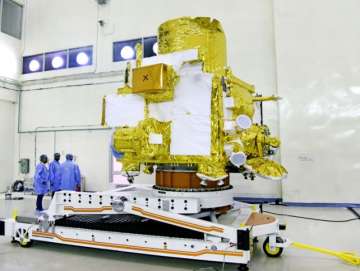Moon landing, the main part of India's second lunar mission --Chandrayaan-2 -- is not like an aircraft taking off from one airport and landing in another.
From the blasting off of the India's heavy lift rocket, Geosynchronous Satellite Launch Vehicle - Mark III (GSLV-Mk III), from the rocket port in Sriharikota on July 15, till the Lander Vikram lands on the moon's surface on September 6, the challenges are many, said Indian Space Research Organisation (ISRO).
To start with, the about 3.844 lakh km distance between the earth and the moon.
Ensuring trajectory accuracy while travelling such a long distance is a challenge as trajectory is influenced by the non-uniform gravity of the earth and the moon, gravitational pull of other astronomical bodies, solar radiation pressure and the moon's true orbital motion.
The next challenge is the deep space communication link between the ISRO and the Chandrayaan-2.
Owing to the distance, limited on-board power, radio signals will be weak with heavy background noise. The signals have to be picked up by large antennas.
While on its way to the moon, the Chandrayaan-2 has to change route from the earth orbit to moon orbit. This will be done by firing on-board motors so that the Chandrayaan-2 is raised to reach the vicinity of the moon's orbit.
Since the moon's location changes continually owing to orbital motion, the intersection of Chandrayaan-2 and the moon's path has to be predicted in advance and accurately. The thrusters on-board the Chandrayaan-2 are fired precisely reducing the velocity for lunar capture. The margin of error in these calculations and manoeuvres is very narrow.
Now comes the challenge of orbiting around the moon. According to ISRO, the lunar gravity is lumpy owing to uneven mass distribution under its surface which in turn influences the spacecraft's orbit. Further precise knowledge of the thermal environment at orbital altitude is a must for keeping on-board electronics safe.
Now comes the main part of the mission, soft landing of Vikram on the moon from Chandrayaan-2. The landing process is divided into "rough braking" and "fine braking".
The descent trajectory of Vikram has to take into account the variation in local gravity. Further the landing site, landscape features should not result in a communication shadow area.
The next challenge is the moon dust. The moon's surface is covered with craters, rocks and dust. Firing the onboard motors close to the surface will result in backward flow of hot gases and miniscule, hard/barbed/jagged dust.
Its negative charge makes it stick to most surfaces, causing a disruption in deployment mechanisms, solar panel and sensor performance.
The other challenge is the extreme surface temperature variations as a lunar day or night lasts 14 earth days. Moreover, the ambient pressure of lunar surface is a hard vacuum. This makes the lunar surface an extremely hostile environment for lander and rover operations, ISRO said.
(Indiatvnews.com has not changed anything except the headline.)
Latest India News
